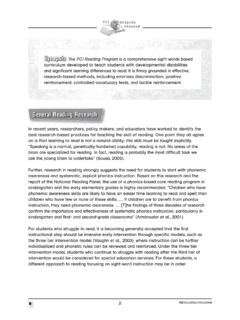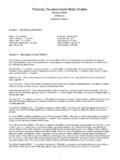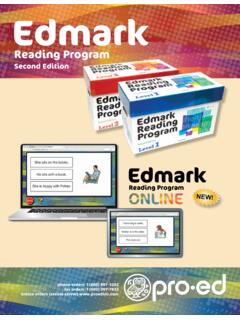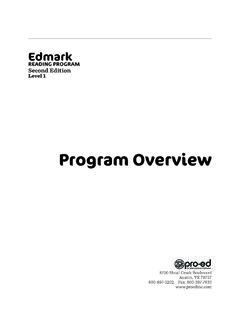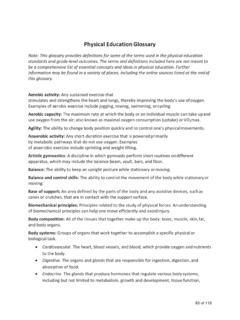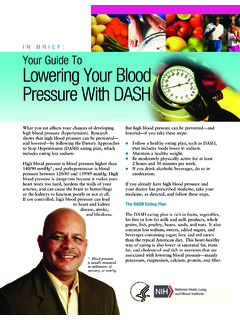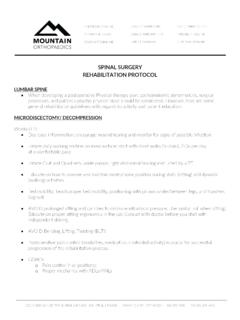Transcription of Hemiplegia/Hemiparesis in Stroke and Brain Injury - PRO-ED
1 Nervous System Disorders 323. Hemiplegia/Hemiparesis in Stroke and Brain Injury hemiplegia in Cerebral Palsy is discussed under Developmental Disorders . Cerebral Palsy Spastic hemiplegia Type. Description hemiplegia is de ned as paralysis on one side of the body caused by Brain damage, while hemi- paresis is weakness or partial paralysis on one side of the body caused by Brain damage, usually opposite the site of the cerebral vascular accident (CVA) or other Brain Injury (Woodsen, 2008, p. 1002). Certain impairments are associated with lesions in a particular hemisphere. For ex- ample, left CVA may cause right hemiparesis , aphasia or other communication de cits, and/or apraxia or motor planning de cits.
2 Right CVA may result in left hemiparesis , visual eld de cits or spatial neglect, poor insight and judgment, and/or impulsive behavior. This chapter focuses on articles that discuss topics in relation to hemiplegia or hemiparesis . The topics most discussed are grip or grasp strength and force, reaching, shoulder pain, and bilateral movement. Other topics discussed include biofeedback, botulinum toxin A, constraint- induced movement therapy, contractures, ne-motor control, functional electrical stimulation, haptic training, neuroprosthesis training, physical tness, postural stabilization, virtual reality, weight bearing, and wheelchair use.
3 Cause Primary cause is a Stroke , although a traumatic Injury or Brain tumor may also cause hemiplegia /. hemiparesis . Assessment Areas Activities of Daily Living/Instrumental ADL: self-care, meal preparation, shopping, driving Education/Work: education or work tasks Play/Leisure: leisure interests and activities Social Participation: life roles and role performance Sensorimotor: bilateral coordination and dexterity, grip and pinch strength, hand function, joint range of motion, pain (especially in the shoulder), transfers Cognitive: perception (especially visual). Psychosocial: depression, anxiety, frustration, social support Context/Environment: home and community safety, home modification, assistive devices Instruments Developed by Occupational Therapy Personnel Box and Block Test.
4 Desrosiers, J., Bravo, G., H bert, R., Dutil, E., & Mercier, L. (1994). Validation of the Box and Block Test as a measure of dexterity of elderly people: Reliability, validity, and norms studies. Archives of Physical Medicine and Rehabilitation, 74, 751 757. Canadian Occupational Performance Measure, 4th ed. (COPM). Law, M., Baptiste, S., Carswell, A., McColl, M. A., Polatajko, H., & Pollock. N. (2004). Toronto, Ontario: Canadian Association of Occupational Therapists. Lowenstein Occupational Therapy Cognitive Assessment (LOTCA). Itzkovich, M., Elazar, B., &. Averbuch, S. (1993). Pequannock, NJ: Maddak. Reaching Performance Scale.
5 Levin, M. F., Desrosiers, J., Beauchemin, D., Bergeron, N., &. Rochette, A. (2004). Development and validation of a scale for rating motor compensations used for reaching patients with hemiplegia : The Reaching Performance Scale. Physical Therapy, 84(1), 18 22. Upper Extremity Performance Test for the Elderly (TEMPA). Desrosiers, J., H bert, R., Dutil, E., & Bravo, G. (1993). Development and reliability of an upper extremity function test for the elderly: The TEMPA. Canadian Journal of Occupational Therapy, 60, 9 16. Quick Reference to Occupational Therapy, 3rd Ed., by K. L. Reed, 2014, Austin, TX: PRO-ED . Copyright 2014 by PRO-ED , Inc.
6 324 Part III. Instruments Developed by Other Professionals and Used by Occupational Therapy Personnel Action Research Arm Test. Lyle, R. C. (1981). A performance test for assessment of upper limb function in physical rehabilitation treatment and research. International Journal of Rehabilitation Research, 4, 483 492. Arm Motor Ability Test (AMAT). Kopp, B., Kunkel, A., Flor, H., Platz, T., Rose, U., Mauritz, K., .. Taub, E. (1997). The Arm Motor Ability Test: Reliability, validity, and sensitivity to change of an instrument for assessing disabilities in activities of daily living. Archives of Physical Medicine and Rehabilitation, 78, 615 620.
7 Ashworth Scale, Modified. Bohannon, R. W., & Smith, M. B. (1987). Interrater reliability of a modified Ashworth Scale of muscle spasticity. Physical Therapy, 67, 206 207. Barthel Index (BI). Mahoney, R., & Barthel, D. (1965). Functional evaluation: The Barthel Index. Maryland State Medical Journal, 14, 612 615. Chedoke-McMaster Stroke Assessment (CMSA). Gowland, C., Stratford, P., Ward, M., Moreland, J., Torresin, W., Van Hullenaar, S., .. Plews, N. (1993). Measuring physical impairment and disability with the Chedoke-McMaster Stroke Assessment. Stroke , 24, 58 63. Fugl-Meyer Assessment. Fugl-Meyer, A., J ak , L., Leyman, I., Olsson, I.
8 , & Steglind, S. (1975). The post- Stroke hemiplegic patient. Part I. A method for evaluation of physical performance. Scandinavian Journal of Rehabilitation Medicine, 7, 13 31. Functional Independence Measure (FIM). Uniform Data System for Medical Rehabilitation. (1997). Guide for the uniform data set for medical rehabilitation (including the FIM instrument), Version Buffalo, NY: State University of New York at Buffalo. Grip Strength/Force. Mathiowetz, V., Weber, K., Volland, G., & Kashman, N. (1984). Reliability and validity of grip and pinch strength evaluation. Journal of Hand Surgery (Am), 9, 222 226. Jebsen Taylor Hand Function Test.
9 Jebsen, R. H., & Taylor, N. (1969). An objective and standardized test of hand function. Archives of Physical Medicine and Rehabilitation, 50, 311 319. Mackinnon-Dellon Disk-Criminator. Dellon, A. L., Mackinon, S. E., & Crosby, P. M. (1987). Reliability of two-joint discrimination measurements. Journal of Hand Surgery, 12, 693 696. Minnesota Manual Dexterity Test (MMDT). Lafayette Instrument. (1991). Lafayette, IN: Author. Motor Activity Log. Uswatte, G., & Taub, E. (1999). Constraint-induced movement therapy: New approaches to outcome measurement in rehabilitation. In D. T. Stuss, G. Winocur, & I. H. Robertson (Eds.), Cognitive rehabilitation: A comprehensive approach (pp.)
10 215 229). Cambridge, UK: Cambridge University Press. Motor-Free Visual Perception Test, 3rd ed. (MVPT-3). Colarusso, R. P., & Hammill, D. D. (2002). Novato, CA: Academic Therapy. Semmes-Weinstein Monofilament Test. Bell-Krotoski, J. A. (1990). Light touch-deep pressure testing using Semmes-Weinstein microfilaments. In J. M. Hunter, L. H. Schneider, E. Mackin, & A. D. Callahan (Eds.), Rehabilitation of the hand: Surgery and therapy (2nd ed., pp. 585 . 593). St. Louis, MO: Mosby. Stroke Impairment Assessment Set (SIAS). Chino, N., Sonoda, S., Domen, K., Saitoh, E., &. Kimura, A. (1994). Stroke Impairment Assessment Set (SIAS): A new evaluation instrument for Stroke patients.

